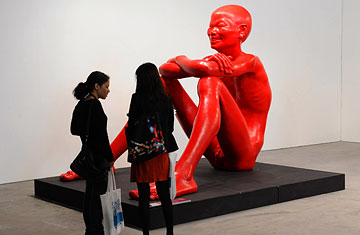
Two visitors stand in front of a sculpture by Chinese artist Chen Wenling at Art Stage Singapore, an international contemporary art fair at the Marina Bay Sands Convention and Exhibition Centre on Jan. 11, 2012.
The abandoned buffet table spoke to the allure of the art falling under the hammer next door. Drawn by paintings by modern Indonesian masters from art auctioneers Borobudur and Larasati, few bidders were distracted by glazed shrimp or sautéed beef. The Jan. 12 sale notched up a record $11.5 million in revenue, a new high for both Southeast Asian auction houses. Further evidence of the Asian art market's resilience could be found at a government-sponsored art fair held at the same time as the auction. 'Art Stage Singapore,' which attracted hundreds of high-end art galleries from across the world, sold signature works like a $1.52 million abstract painting by German artist Gerhard Richter.
The buoyancy of both events is but another example of the resiliency of the Asian art market. It has been rising steadily over the last decade, barely slowed by the 2008-09 global financial crisis and, more recently, appears to be ignoring a two-year-old European debt crisis that has otherwise stalled stock and property markets across most of Asia. In 2004, for instance, global auction house Christie's grossed $179 million from its Asia-based sales. By 2011, the auction house had grossed $904 million from sales in the region.
Even so, experts say, the explosive growth of the last six to seven years appears to be slowing somewhat. "The market is not as strong as it was a year ago," says Jasdeep Sandhu, owner of Gajah Gallery in Singapore, which represents auction market darlings like Indonesian artist I. Nyoman Masriadi. At the Borobudur/Larasati auction, for example, very large paintings like Indonesian master Affandi's "Barong and Rangda," a 1960 work depicting the shadow dance between the Balinese spirits of good and evil, generated enthusiastic bidding and finally fetched $500,000 (excluding the buyer's commission), roughly double its high estimate. Yet a striking 1974 nude entitled "Nude and the Snake" by Sudjojono, a contemporary of Affandi and a pillar of Indonesian modernism, sold for far less, $107,000 (excluding commission), below the upper end of its estimated range.
"The bidding isn't as crazy as it used to be," says Dexter How, a Southeast Asian specialist with Singapore-based auctioneer 33Auction. The relatively tepid autumn sales of Sotheby's and Christie's in Hong Kong last year prove his point. For both auction houses, the 2011 autumn sales generated roughly 10 to 25 per cent less than their preceding spring sales. And though the Borobudur/Larasati sale was considered a surprise success, some experts point out that the idea of pooling buyers together and shaving marketing costs by holding a joint sale is itself a sign of lowered expectations. Plus, says How, "some of the works were priced reasonably."
So is a sudden drop around the corner? Experts say no, pointing to the broadening of the Asian art world over the last decade as a stabilizing force. Asian collectors, for example, are increasingly diversifying their collections, branching out into works from other countries. Taiwanese collectors, for instance, are buying more Indonesian art. A recent surge in new museums and galleries, particularly in China, where an average of one hundred new museums opens each year, as well as more academic art scholarship about Asian art, has also underpinned the market. All of which makes a precipitous collapse, according to Jehan Chu, director of Hong Kong-based art consultancy Vermillion Art Collections, "hard to imagine."
